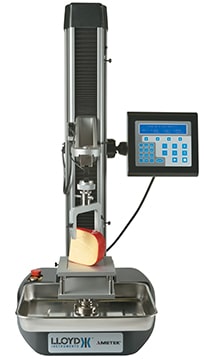Texture analyzers are designed to perform scientific analysis and measurement of the texture of particular objects. Texture analysis is important aspect of quality control as it allows the evaluation and control of the factor impacting the quality, processing and handling of the products. A texture analyzer is commonly used for textural testing within food industry, pet food, pharmaceutical ans cosmetics industry.
Texture Measurement Principle
As texture is a physical property related to touch, it can be easily measured by mechanical testing method such as force testing. Texture measurement is performed by physically deform a test sample in a controlled environment and measure its response to the applied force. The textural characteristics of the sample are gauged from these results. The force applied during the testing are simulated with a wide range of jigs and fixtures to mimic the real texture testing. Such tests can be compression, tension and flexure testing to measure hardness, crispiness, crunchiness, softness, springiness, tackiness and other mechanical properties. A texture analyzer device performs the test automatically and displays the results on-screen.
Texture analyzers are designed to perform scientific analysis and measurement of the texture of particular objects. Texture analysis is important aspect of quality control as it allows the evaluation and control of the factor impacting the quality, processing and handling of the products. A texture analyzer is commonly used for textural testing within food industry, pet food, pharmaceutical ans cosmetics industry.
Texture Measurement Principle
As texture is a physical property related to touch, it can be easily measured by mechanical testing method such as force testing. Texture measurement is performed by physically deform a test sample in a controlled environment and measure its response to the applied force. The textural characteristics of the sample are gauged from these results. The force applied during the testing are simulated with a wide range of jigs and fixtures to mimic the real texture testing. Such tests can be compression, tension and flexure testing to measure hardness, crispiness, crunchiness, softness, springiness, tackiness and other mechanical properties. A texture analyzer device performs the test automatically and displays the results on-screen.


